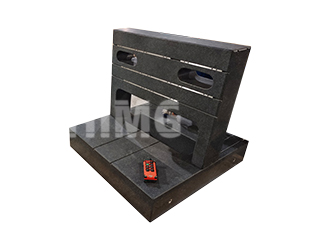When engineers and metrologists select a precision granite platform for demanding measurement and assembly tasks, the final decision often centers on a seemingly simple parameter: its thickness. Yet, the thickness of a granite surface plate is far more than a simple dimension—it is the foundational factor that dictates its load capacity, vibration resistance, and ultimately, its ability to maintain long-term dimensional stability.
For high-accuracy applications, the thickness isn’t chosen arbitrarily; it’s a critical engineering calculation based on established standards and rigorous principles of mechanical deflection.
The Engineering Standard Behind Thickness Determination
The primary purpose of a precision platform is to serve as a perfectly flat, unmoving reference plane. Therefore, the thickness of a granite surface plate is primarily calculated to ensure that under its maximum anticipated load, the plate’s overall flatness remains strictly within its specified tolerance grade (e.g., Grade AA, A, or B).
This structural design adheres to leading industry guidelines, such as the ASME B89.3.7 standard. The key principle in thickness determination is minimizing deflection or bending. We calculate the required thickness by considering the granite’s properties—specifically its Young’s Modulus of Elasticity (a measure of stiffness)—along with the plate’s overall dimensions and the expected load.
The Authority Standard for Load Capacity
The widely accepted ASME standard links thickness directly to the plate’s load-bearing capacity using a specific safety margin:
The Rule of Stability: The granite platform must be thick enough to support the total normal load applied to the center of the plate, without deflecting the plate along any diagonal by more than half of its overall flatness tolerance.
This requirement ensures the thickness provides the necessary rigidity to absorb the applied weight while preserving sub-micron accuracy. For a larger or more heavily loaded platform, the required thickness increases dramatically to counteract the heightened bending moment.
Thickness: The Triple Factor in Precision Stability
The platform’s thickness acts as a direct amplifier of its structural integrity. A thicker plate provides three major, interconnected benefits essential for precision metrology:
1. Enhanced Load Capacity and Flatness Retention
Thickness is crucial for resisting the bending moment caused by heavy objects, such as large coordinate measuring machines (CMMs) or heavy components. Choosing a thickness that exceeds the minimum requirement provides an invaluable safety margin. This extra material gives the platform the necessary mass and internal structure to distribute the load effectively, thus dramatically reducing the plate’s deflection and ensuring the required surface flatness is maintained over the platform’s entire life.
2. Increased Dynamic Stability and Vibration Damping
A thicker, heavier granite slab inherently possesses greater mass, which is paramount for dampening mechanical and acoustic noise. A massive platform has a lower natural frequency, making it significantly less susceptible to external vibrations and seismic activity common in industrial environments. This passive dampening is vital for high-resolution optical inspection and laser alignment systems where even microscopic movement can corrupt a process.
3. Optimizing Thermal Inertia
The increased volume of material slows down temperature fluctuations. While high-quality granite already boasts a very low coefficient of thermal expansion, greater thickness provides superior thermal inertia. This prevents rapid, non-uniform thermal deformation that could occur when machines heat up or air conditioning cycles, ensuring that the platform’s reference geometry remains consistent and stable over long operational periods.
In the world of precision engineering, the thickness of the granite platform is not an element to minimize for cost savings, but a foundational structural element to optimize, ensuring your setup delivers the repeatable and traceable results required by modern manufacturing.
Post time: Oct-14-2025

